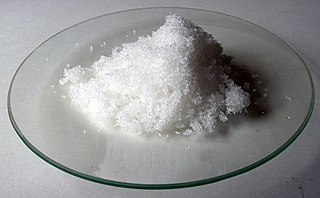
Sodium nitrate is the chemical compound with the formula NaNO
3. This alkali metal nitrate salt is also known as Chile saltpeter to distinguish it from ordinary saltpeter, potassium nitrate. The mineral form is also known as nitratine, nitratite or soda niter.

Thiomersal (INN), or thimerosal, is an organomercury compound. It is a well-established antiseptic and antifungal agent.

Benzalkonium chloride, also known as alkyldimethylbenzylammonium chloride (ADBAC) and by the trade name Zephiran, is a type of cationic surfactant. It is an organic salt classified as a quaternary ammonium compound. ADBACs have three main categories of use: as a biocide, a cationic surfactant, and a phase transfer agent. ADBACs are a mixture of alkylbenzyldimethylammonium chlorides, in which the alkyl group has various even-numbered alkyl chain lengths.

An antifungal medication, also known as an antimycotic medication, is a pharmaceutical fungicide or fungistatic used to treat and prevent mycosis such as athlete's foot, ringworm, candidiasis (thrush), serious systemic infections such as cryptococcal meningitis, and others. Such drugs are usually obtained by a doctor's prescription, but a few are available over the counter (OTC). The evolution of antifungal resistance is a growing threat to health globally.
Carbachol, also known as carbamylcholine and sold under the brand name Miostat among others, is a cholinomimetic drug that binds and activates acetylcholine receptors. Thus it is classified as a cholinergic agonist. It is primarily used for various ophthalmic purposes, such as for treating glaucoma, or for use during ophthalmic surgery. It is generally administered as an ophthalmic solution.

Imidazole (ImH) is an organic compound with the formula C3N2H4. It is a white or colourless solid that is soluble in water, producing a mildly alkaline solution. In chemistry, it is an aromatic heterocycle, classified as a diazole, and has non-adjacent nitrogen atoms in meta-substitution.

Allergic conjunctivitis (AC) is inflammation of the conjunctiva due to allergy. Although allergens differ among patients, the most common cause is hay fever. Symptoms consist of redness, edema (swelling) of the conjunctiva, itching, and increased lacrimation. If this is combined with rhinitis, the condition is termed allergic rhinoconjunctivitis (ARC).

Alpinia nutans, the shellflower, or dwarf cardamom, is a Southeast Asian plant of the ginger family (Zingiberaceae), and is a medicinal plant used to control hypertension, as diuretic, antifungal, and antiulcer. In Japan it is used as food preservative.

Artificial tears are lubricating eye drops used to relieve dryness and irritation of the ocular surface. Dry eye syndrome is a common ocular surface disorder and is characterized by disruption of the tear film and increased inflammation.

Mersalyl (Mersal) is an organomercury compound and mercurial diuretic. It is only rarely used as a drug, having been superseded by diuretic medications that do not contain mercury and are therefore less toxic. It features a Hg(II) centre. Mersalyl was originally adapted from calomel (Hg2Cl2), a diuretic discovered by Paracelsus.

Organomercury chemistry refers to the study of organometallic compounds that contain mercury. Typically the Hg–C bond is stable toward air and moisture but sensitive to light. Important organomercury compounds are the methylmercury(II) cation, CH3Hg+; ethylmercury(II) cation, C2H5Hg+; dimethylmercury, (CH3)2Hg, diethylmercury and merbromin ("Mercurochrome"). Thiomersal is used as a preservative for vaccines and intravenous drugs.

Brinzolamide is a carbonic anhydrase inhibitor used to lower intraocular pressure in patients with open-angle glaucoma or ocular hypertension.

Loteprednol is a topical corticosteroid used to treat inflammations of the eye. It is marketed by Bausch and Lomb as Lotemax and Loterex.

Phenylmercuric acetate is an organomercury compound used as a preservative, disinfectant, and antitranspirant.
Stearalkonium chloride is a type of benzalkonium chloride which is used as an anti-static agent, a surfactant and an antimicrobial. It is an ingredient in some cosmetics and hair care products, particularly conditioners. It was originally designed by the fabric industry for use as a fabric softener.

Besifloxacin (INN/USAN) is a fourth-generation fluoroquinolone antibiotic. The marketed compound is besifloxacin hydrochloride. It was developed by SSP Co. Ltd., Japan, and designated SS734. SSP licensed U.S. and European rights to SS734 for ophthalmic use to InSite Vision Incorporated in 2000. InSite Vision developed an eye drop formulation (ISV-403) and conducted preliminary clinical trials before selling the product and all rights to Bausch & Lomb in 2003.
Nitromersol (metaphen) is a mercury-containing organic compound that is primarily used as an antiseptic and disinfectant. It is a brown-yellow solid that has no odor or taste, does not irritate the skin or mucous membranes, and has no impact on rubber or metallic instruments, including surgical and dental tools.

Phenyl(trichloromethyl)mercury is an organomercury compound with the formula C6H5HgCCl3. It is a white solid that is soluble in organic solvents. The compound is used as a source of dichlorocarbene, e.g. in cyclopropanation reactions, illustrated with tetrachloroethylene as a substrate, the product being hexachlorocyclopropane:

4-Aminophenylmercuric acetate (CH3CO2HgC6H4NH2, also known as 4-(Acetoxymercurio)aniline or APMA), is an organomercurial compound and thiol-blocking reagent used in experimental biology and chemistry to activate matrix metalloproteinases and collagenase proteolytic enzymes. The material is highly toxic.

Omidenepag, sold under the brand name Eybelis among others, is a medication used for the treatment of glaucoma and ocular hypertension.






















